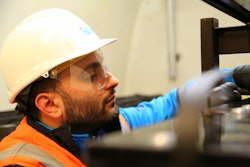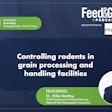
In the feed and grain industry, managers often conduct exit interviews to gather feedback when employees leave. These interviews can provide valuable insights into what’s working well and what might need improvement.
However, a proactive approach — known as the "stay interview" — can offer even greater benefits by addressing employee needs before they decide to leave.
The stay interview is a powerful tool to enhance employee engagement, retention and overall satisfaction. By adopting this practice, managers can create a workplace culture that fosters open communication and alignment between leadership and employees.
Key objectives of a stay interview
Employee turnover is one of the most significant challenges businesses face today. It is costly — not only in terms of time and money but also in the loss of institutional knowledge essential to your feed and grain operations. Institutional knowledge refers to the unique understanding of how things run within your business, which can take years to build and is often difficult to replace.
Research by McKinsey & Co. has found the direct costs of turnover, including recruitment, training and lost productivity, can amount to 50-60% of an employee's annual salary. These numbers highlight the need for strategies to mitigate turnover and retain talented employees.
A stay interview is an effective way to address this challenge. By asking employees about their experiences and listening to their feedback, managers can uncover insights that help reduce turnover and strengthen workplace engagement. Moreover, these conversations contribute to a culture where employees feel valued, heard and motivated to stay.
Given the recent increase in turnover rates across all industries, including feed and grain, investing in retention strategies like stay interviews is more critical than ever.
The stay interview’s background
Richard Finnegan, a leading expert on employee engagement and retention, introduced the concept of the stay interview through his work at the Finnegan Institute. He defines the stay interview as a “structured discussion a leader conducts with each individual employee to learn the specific actions the leader must take to strengthen that employee’s engagement and retention with the organization.”
Unlike traditional annual evaluations, stay interviews are intentionally focused on enhancing employee satisfaction and alignment with organizational goals. Many organizations that have implemented stay interviews report significant improvements, with some experiencing up to a 70% reduction in turnover rates.
While formal stay interview programs may require a considerable time commitment, informal versions — short conversations held periodically — can also yield meaningful results. Using structured questions, active listening and note-taking, managers can foster a culture of continuous engagement and trust.
Building relationships through mentorship
Stay interviews also serve as opportunities to mentor employees. Mentorship is a valuable strategy for building strong relationships, boosting morale and fostering professional growth. A study by the Springtide Research Institute found that younger people, particularly those ages 13-25, said they are more motivated when they feel their supervisor cares about them personally.
In fact, 73% of participants said they perform better when they sense genuine concern from their supervisors. While maintaining professional boundaries is important, mentorship can create meaningful connections that benefit the employee and the organization.
Brenda Do of Upwork describes mentorship as “transferring knowledge, much like a teacher or coach.”
Effective mentorship is built on trust, candid communication and mutual respect. Here are four key components of successful mentorship:
- Speaking candidly: Provide honest, constructive feedback.
- Advocating for employees: Champion their success by offering opportunities for growth and introducing them to valuable contacts.
- Encouraging resilience: Help employees navigate challenges by leveraging their strengths.
- Mindful sharing: Share relevant experiences without oversharing personal information.
Through mentorship, employees develop problem-solving skills and independence. These qualities benefit the individual and strengthen the overall organization. For instance, guiding employees to discover solutions independently empowers them to take initiative and build confidence in their decision-making abilities.
The role of curiosity in employee development
Curiosity is a powerful driver of personal and professional growth. Asking employees questions like, “What are you curious about?” can spark meaningful discussions and encourage exploration. Curiosity leads to learning, creativity and adaptability—all critical traits for success.
Research by Korn Ferry, a global business consulting firm, underscores the importance of curiosity in leadership and organizational growth. CEO Gary Burnison notes that since the 2020 pandemic, the world has experienced “nonstop ambiguity,” requiring leaders to remain open-minded and adaptable.
Curiosity helps individuals identify emerging trends and take proactive steps to address challenges and seize opportunities. By fostering curiosity in employees, managers can prepare their teams to thrive in an ever-changing business landscape.
Curiosity is also one of the most significant predictors of success. Encouraging employees to explore their interests and expand their skills not only benefits the individual but also enhances the organization’s ability to innovate and adapt to new demands.
Implementing the stay interview
Introducing stay interviews doesn’t have to be a complex or time-intensive process. Even informal discussions can provide valuable insights into employee satisfaction and engagement. Consider incorporating these key questions into your conversations:
- “What motivates you to stay here?”
- “What have you heard people say they like about working here?”
- “What have you heard people say they dislike about working here?”
Framing questions this way encourages employees to share candid feedback without feeling pressured to reveal personal concerns. The goal is to create a safe environment where employees feel comfortable discussing their experiences and needs.
For larger teams, consider starting with a pilot program, conducting stay interviews with a smaller group of employees. This allows managers to refine the process and identify the most effective approaches before scaling up to include the entire organization.
The business case for stay interviews
Finnegan emphasizes that while stay interviews won’t solve every challenge, they will improve engagement and retention by strengthening relationships between leaders and employees. These interviews offer a practical way to identify areas for improvement, address employee concerns and build a stronger, more aligned workforce.
The time investment required for stay interviews is outweighed by the potential cost savings from reduced turnover. By retaining employees, businesses avoid the high costs of recruitment, onboarding and training while preserving institutional knowledge and productivity. Additionally, fostering a positive work environment increases employee satisfaction and motivation, leading to better performance and overall success.
Employee retention is a top priority in today’s competitive job market, and stay interviews are a valuable tool for achieving this goal. By proactively engaging with employees, listening to their feedback and addressing their concerns, managers can create a workplace where people feel valued and motivated to contribute.
While some aspects of the stay interview may overlap with annual evaluations, this process is more intentional and focused on fostering a culture of continuous engagement and improvement. The investment of time and effort required to implement stay interviews is well worth it, resulting in a more satisfied, productive and loyal workforce.


















